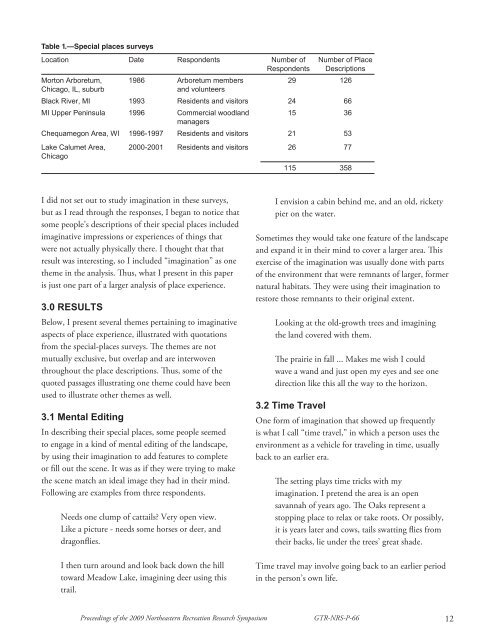Proceedings of the 2009 northeastern recreation research symposium
Proceedings of the 2009 northeastern recreation research symposium
Proceedings of the 2009 northeastern recreation research symposium
Create successful ePaper yourself
Turn your PDF publications into a flip-book with our unique Google optimized e-Paper software.
Table 1.—Special places surveys<br />
Location Date Respondents Number <strong>of</strong><br />
Respondents<br />
Morton Arboretum,<br />
Chicago, IL, suburb<br />
1986 Arboretum members<br />
and volunteers<br />
I did not set out to study imagination in <strong>the</strong>se surveys,<br />
but as I read through <strong>the</strong> responses, I began to notice that<br />
some people’s descriptions <strong>of</strong> <strong>the</strong>ir special places included<br />
imaginative impressions or experiences <strong>of</strong> things that<br />
were not actually physically <strong>the</strong>re. I thought that that<br />
result was interesting, so I included “imagination” as one<br />
<strong>the</strong>me in <strong>the</strong> analysis. Th us, what I present in this paper<br />
is just one part <strong>of</strong> a larger analysis <strong>of</strong> place experience.<br />
3.0 RESULTS<br />
Below, I present several <strong>the</strong>mes pertaining to imaginative<br />
aspects <strong>of</strong> place experience, illustrated with quotations<br />
from <strong>the</strong> special-places surveys. Th e <strong>the</strong>mes are not<br />
mutually exclusive, but overlap and are interwoven<br />
throughout <strong>the</strong> place descriptions. Th us, some <strong>of</strong> <strong>the</strong><br />
quoted passages illustrating one <strong>the</strong>me could have been<br />
used to illustrate o<strong>the</strong>r <strong>the</strong>mes as well.<br />
3.1 Mental Editing<br />
In describing <strong>the</strong>ir special places, some people seemed<br />
to engage in a kind <strong>of</strong> mental editing <strong>of</strong> <strong>the</strong> landscape,<br />
by using <strong>the</strong>ir imagination to add features to complete<br />
or fi ll out <strong>the</strong> scene. It was as if <strong>the</strong>y were trying to make<br />
<strong>the</strong> scene match an ideal image <strong>the</strong>y had in <strong>the</strong>ir mind.<br />
Following are examples from three respondents.<br />
Needs one clump <strong>of</strong> cattails? Very open view.<br />
Like a picture - needs some horses or deer, and<br />
dragonfl ies.<br />
I <strong>the</strong>n turn around and look back down <strong>the</strong> hill<br />
toward Meadow Lake, imagining deer using this<br />
trail.<br />
Number <strong>of</strong> Place<br />
Descriptions<br />
29 126<br />
Black River, MI 1993 Residents and visitors 24 66<br />
MI Upper Peninsula 1996 Commercial woodland<br />
managers<br />
15 36<br />
Chequamegon Area, WI 1996-1997 Residents and visitors 21 53<br />
Lake Calumet Area,<br />
Chicago<br />
2000-2001 Residents and visitors 26 77<br />
115 358<br />
I envision a cabin behind me, and an old, rickety<br />
pier on <strong>the</strong> water.<br />
Sometimes <strong>the</strong>y would take one feature <strong>of</strong> <strong>the</strong> landscape<br />
and expand it in <strong>the</strong>ir mind to cover a larger area. Th is<br />
exercise <strong>of</strong> <strong>the</strong> imagination was usually done with parts<br />
<strong>of</strong> <strong>the</strong> environment that were remnants <strong>of</strong> larger, former<br />
natural habitats. Th ey were using <strong>the</strong>ir imagination to<br />
restore those remnants to <strong>the</strong>ir original extent.<br />
Looking at <strong>the</strong> old-growth trees and imagining<br />
<strong>the</strong> land covered with <strong>the</strong>m.<br />
Th e prairie in fall ... Makes me wish I could<br />
wave a wand and just open my eyes and see one<br />
direction like this all <strong>the</strong> way to <strong>the</strong> horizon.<br />
3.2 Time Travel<br />
One form <strong>of</strong> imagination that showed up frequently<br />
is what I call “time travel,” in which a person uses <strong>the</strong><br />
environment as a vehicle for traveling in time, usually<br />
back to an earlier era.<br />
<strong>Proceedings</strong> <strong>of</strong> <strong>the</strong> <strong>2009</strong> Nor<strong>the</strong>astern Recreation Research Symposium GTR-NRS-P-66<br />
Th e setting plays time tricks with my<br />
imagination. I pretend <strong>the</strong> area is an open<br />
savannah <strong>of</strong> years ago. Th e Oaks represent a<br />
stopping place to relax or take roots. Or possibly,<br />
it is years later and cows, tails swatting fl ies from<br />
<strong>the</strong>ir backs, lie under <strong>the</strong> trees’ great shade.<br />
Time travel may involve going back to an earlier period<br />
in <strong>the</strong> person’s own life.<br />
12
















